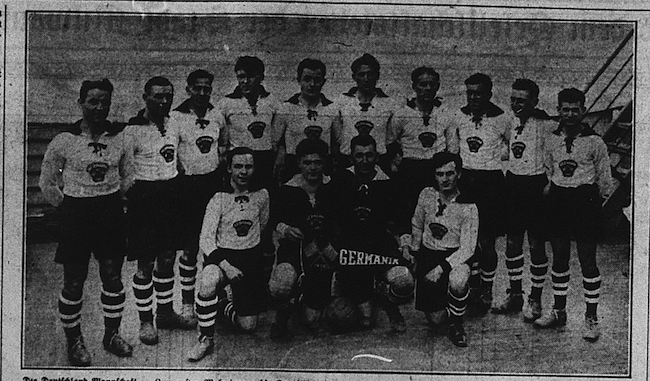
Prior to 1930, there had only been three American soccer tours of Europe. The first had been the US men’s national team soccer team tour of Norway and Sweden in 1916 amidst the First World War.[1] Next, Bethlehem Steel played in Scandinavia in 1919.[2] Finally, in 1920, St. Louis Soccer Club’ crossed the Atlantic for round of games in Sweden.[3] While the US national team played games against European opponents after its exit from the 1924 and 1928 Olympics, another decade passed before plans for a new European soccer tour began to appear in the public eye in December of 1929. The Milwaukee Herold carried a snippet noting that Fritz Rohrmann of Milwaukee’s Deutscher Sport Verein was working to organize games for an American team to play in Germany.[4] Then in March 1930 came a mention in the pages of the Berliner Börsen-Zeitung, which noted the local club SC Minerva Berlin 1893 was in negotiations with a team to be comprised of ethnic Germans and Austrians out of Milwaukee.[5]
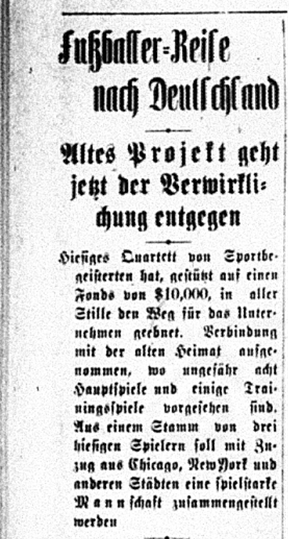
The German character of Milwaukee was established through the significant influx of immigration that began in the middle of the nineteenth century. By 1930, nearly 40 percent of the city’s population was made up of German immigrants or first-generation German Americans.[6]
There had always been tension regarding assimilation between the German community and the larger American community. Germans established their own churches, schools, and newspapers in their native language. This tension came to a high point with the significant anti-German sentiment during the First World War. In the 1920s, efforts were made by the German community toward greater assimilate but German institutions still stood strong. The list of notices published in the Milwaukee Herold, the most renowned German language newspaper in town, regarding the various German clubs, societies, and groups was immense. These organizations represented such areas of singing, theater, mutual insurance, war veterans, socialism, architecture, engineering, gymnastics, and, of course, soccer.
Soccer in Milwaukee had originated with British immigrants. Clubs such as Caledonians, Sons of St. George, Thistles, American British Canadians, and British War Veterans were some of the first clubs established in the Milwaukee area. However, by 1930, German clubs dominated the ranks of the State and Municipal Leagues, providing twenty-five of the thirty-four entries across the two divisions of the State League and the three divisions of the Municipal League.
Big revelations about a possible tour came later in March 1930 in the Milwaukee Herold. The report noted that while it had not been a secret that efforts to organize a tour had been underway, the paper had made inquiries and related a trove of information regarding the prospective tour.[7]
The tour was the creation of four figures linked to one of Milwaukee’s German clubs, the Deutscher Sport Verein. President Otto Fitterer, Vice-President Emil Fitterer, Secretary Fritz Rohrmann, and Sporting Director Fred Patek had built an organization named “DSV Germania” along with $10,000 of funding ($178,000 in 2024 dollars), to put together a strong soccer team and refresh relations with the old homeland. The funding covered all of the players’ expenses – travel, accommodations, and meals.[8]
The leaders had been in transatlantic conversation for months with Dr. Martin, chair of the Brandenburg Sports Association, and T. Hitzemeyer, chair of SC Minerva 1893. Through the efforts of those two figures, the trip obtained the approval of the German Football Association.[9]
Other figures who were instrumental in getting the tour launched were Eugen Held, a former Milwaukeean living in New York City, and Reinhold Oeschler, chairman of the Chicago Protection Association of German Sports Clubs. They put together the request for permission to the United States Soccer Football Association (USSFA) to undertake a tour. Interest in the tour was expressed by clubs in Germany like Dresdener Sport Club, Mannheim, and others. Martin and Hitzemeyer suggested the cities of Hamburg, Kiel, Stettin, Berlin, Leipzig, Nuremberg, Karlsruhe, Munich, and Vienna should be part of the tour.[10]
The original vision for the 16-player team was that it would be primarily comprised of players from Milwaukee, Chicago, and New York. Detroit, Cleveland, and St. Louis were noted as other possible sources of talent. The Milwaukeeans originally envisioned as participants were Frank (Hannes) Kondziela and Herman Rosteck of Deutscher Sport Club, as well as Heini Kärcher of Vienna AC. Adolf Patek, a famous striker formerly of Sparta Prague, was considered as a candidate for the coaching role. Preliminary plans were for the team to gather in Chicago and then play exhibition games in the Midwest and East before a mid-June departure for Germany from New York.[11]
By the end of March, a preliminary schedule was firmed up:
- May 29: Hamburger Sport Verein
- June 1: Hannover 96
- June 8: Minerva Berlin
- June 15: Halle 96
- June 21: Eintracht Frankfurt
- June 25: FB 04 Würzburg or Karlsruhe FV
An additional game or two in Austria — possibly in Vienna — was also contemplated.
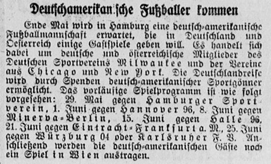
By April 1930, plans were finalized for the trip. According to the Duisburger General Anzeiger, Dr. Theodor Lewald, President of the German National Committee for Physical Exercise (and later President of the organizing committee for the 1936 Berlin Olympic Games), was of significant assistance. There was discussion about the team playing “showcase” games in Cleveland, Chicago, and Milwaukee upon its return.[12]
On April 12, the New York Staats Zeitung reported further details of the tour. The entourage would depart on May 14 from New York on the steamer St. Louis of the Hamburg-American Line, arriving in Hamburg ten days later. The tour would open with a match against Hamburg SV. The report also confirmed the German FA had endorsed the tour. With that notice, Dr. G. Randolph Manning, chair of the Foreign Committee of the USSFA (and previously the first president), gave permission from the USA’s governing body.[13]
Preparation
On Easter Sunday 1930, a select team from the New York’s Deutsch-Amerikanische Fussball Bund (DAFB) played an exhibition match against an all-star team from the professional Eastern Soccer League at the Suydam Oval in Brooklyn. The DAFB squad was assembled by the tour’s New York representative Eugen Held. Expectations were that nine or ten players on the DAFB team would be selected for the tour. Two players not on the DAFB squad, Theodor Steinbrenner of Newark Deutscher Football Club and Georg Prengel of Brooklyn Deutscher Sport Club, were injured but were expected to be selected for the DSV Germania squad if they recovered in time. Otto Schneider was also under consideration, and the New Yorker Staats-Zeitung advocated for his inclusion in the game, even though he played for the ASL’s Newark Americans.[14]
In the end, Steinbrenner’s injury kept him from participating. Rudi Koerner (Deutscher Fussball Club – New York) took the inside left position, and Duersch (Elizabeth Sport Club, New Jersey) played as center forward.
The substitutes were Wilhelm Herkert (German Hungarians), Fritz Wittmann (Vienna), Geiger (Elizabeth), Staab (Phoenix-Philadelphia), von Ohlen (German Americans) and Vogel (Paterson). All saw playing time except for Staab.
The exhibition game itself was attended by a crowd of 2,500. According to the New York Times, the DAFB squad was in control the entire game and went into halftime with a two-goal lead. They scored twice more in the second half before the Eastern Leaguers tallied a consolation goal. Three more goals for the DAFB side followed. Koerner lead the goal scorers with four. Muller, Kunter, and Kaiser were the other goal scorers.[15]
The Milwaukee Herold included a telegram from two of the Milwaukee leaders, Fred Patek and Otto Fitterer:
German team wins sensationally 7:1, break 2:0. Opponent complete. Nobody hoped to win. 2,500 paying spectators. German defense was brilliant, as was the attack after the break. Goals were scored by Koerner (4), Kunter, Kaiser and Moeller. The opponent scored a consolation goal at 4-0 with a penalty. Nice game. Professionals completely overrun.—Patek, Fitterer.[16]
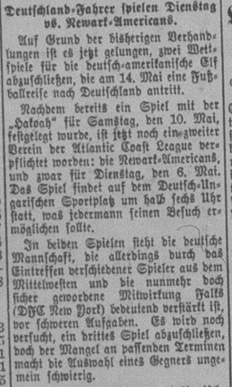
After the game, there was a meeting at the German American Athletic Club, then located at Scheffel Hall, 190 Third Avenue in Manhattan.[17] Five players were signed for the trip: Wilhelm Herkert (German Hungarians), Joseph Halstenbach (DFC – New York), Willi Sumser (DFC – New York), Georg Mueller (DFC – Newark), and Rudolph Kuntner (Wiener Sportklub). Despite being injured, Steinbrenner was also selected. Two ASL players who had not participated – the Otto Schneider as well as Bernhard Gruenfeld (New York Giants) – also joined Germania. Gruenfeld had previously played for Stuttgarter Kickers, a club in the highest league in the German states of Baden and Württemberg.
Training for the tour was to begin on May 3 with the arrival of the players from the Midwest. According to the New Yorker Staats-Zeitung, the expected players were Milwaukee’s Heini Kärcher, Chicago’s Richard Buschner, and Grand Rapids’ Paul Esenwein. Also expected were Herman Rosteck of Milwaukee, along with two other names, Pfitzer and Gonzelas.
As preparations continued, the Eastern League demanded a rematch, and Thomas Cahill, secretary of the USSFA, extended his congratulations to the DAFB team.
The commitments of Willi Falk, Rudi Koerner, and Theo Wegener were still pending. Falk, who had played in Germany for Wacker Munich and made one appearance for the German national team in 1927, was responsible for the training of the Easterners.[18]
After the arrival of the other players on May 3, exhibitions were to be played against New York Hakoah, a DAFB select team, and the United States national team (which was then preparing for the inaugural World Cup in Uruguay where it would finish in third place). The USSFA had been duly impressed by the game against the Eastern Soccer League select team and was itself trying to organize a match between the Germania squad and the national team.[19]
The Germania representative in Germany, Paul Hitzemeyer, sent a telegram relating that twenty-eight leading clubs had applied for games against the traveling squad. However, the German FA had only approved six of them. The provisional schedule stood as:
- May 29: Hamburg SV
- June 1: Hannover 96
- June 8: Minerva-Berlin
- June 1: Halle 96
- June 18: Karlsruhe FV
- June 22: Eintracht Frankfurt
An additional game on June 29 against a professional team in Vienna was planned but did not take place.
The German FA did commit to send a delegation to Hamburg to welcome Germania, and Dr. William R. Manning, a member of the executive board of the USSFA, promised to appear at some of the games.[20]
The Duisburger General Anzeiger reported on April 29 that the Germania squad had a practice game, but the opponent was not noted.
Some reports indicated Schneider, Kärcher, Buschner, Kondziela, Rosteck, and the goalkeeper Pfitzer from Chicago Sparta, were reserve players for the Germania squad.[21] However, the Milwaukeeans and Chicagoans could not have been there. Kärcher and Kondziela were being feted at a farewell party in Milwaukee on May 3, and they traveled together with the Chicago contingent to New York.
Two additional warm-up games were scheduled: May 6 against the Newark Americans at the German Hungarian Field and May 10 against Hakoah.[22] Meanwhile, the Hohenstein-Ernstthaler Tageblatt und Anzeiger reported that the tour was in danger because of Germania’s desire to augment the team with professionals. The German FA at the time did not look favorably on professional football.[23]
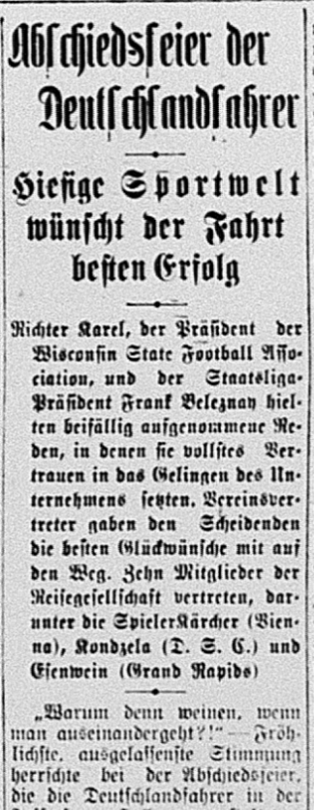
On May 3, there was a farewell party at Jefferson Hall in Milwaukee, a place used frequently by the city’s many German clubs and societies, for the ten midwestern members of the Germania contingent. Kärcher and Kondziela, along with Esenwein of Grand Rapids, were the guests of honor.
Speeches were given by local sports dignitaries with Richard Baumann of the Milwaukee Herold acting as emcee. Judge John C. Karel, President of the Wisconsin State Football Association (WSFA), spoke, as did Frank Beleznay, President of the Wisconsin State League. Otto Fitterer, President of DSV Germania, spoke on the purpose of the tour. He also delivered a poem. On behalf of the local Deutscher Sport Verein, Georg Froboese (later infamous for his leadership of the Midwest branch of the German American Bund) offered his best wishes to the DSV members who would be traveling, and he hoped for a victory in his hometown of Hannover. [24] On behalf of the Deutscher Sport Club, Ernst Fisher offered his support, particularly for club member Hannes Kondziela. Heinrich Lange spoke on behalf of Vienna AC and presented a bouquet of flowers to their representative, Heini Kärcher. Other speeches were given by Germanians Fred Patek and Emil Fitterer. The three players selected for the tour gave short responses to the speeches, expressing their promise to represent German American sport and to bring home some victories.[25] Singing and dancing were also part of the evening’s festivities.
Gathering
The Midwest contingent departed from Milwaukee on May 7. For the first time, Fred Patek of Milwaukee Deutscher Sport Verein was reported to be the manager of the Germania team. The travel party was joined by the Chicago-based players Buschner and Wegener in the Windy City.[26]
According to the New Yorker Staats-Zeitung, there would be meeting at the Austrian Hall, at 245 East 82nd Street, of the Eastern players and the newly arrived Midwesterners to discuss the trip. The board of the DAFB would also be attending the meeting.[27]
The exhibition game against Hakoah was cancelled because Hakoah had several players injured and had a difficult upcoming cup game. The exhibition against the NYSFA select team was then changed from Sunday to Saturday.[28] As the New Yorker Staats-Zeitung briefly noted, “it was a very-one sided and uninteresting game.”[29] Germania posted a 5-0 victory in the exhibition match, which featured the first appearances of the Midwestern players (see the appendix for match details for this and all subsequent matches reported in this essay). The newcomers made an immediate impact with Esenwein scoring the first goal and Kärcher netting the next two.[30]
On May 13, the Germania club lined up against the Newark Americans of the Atlantic Coast League. The Milwaukee Herold’s brief report on the game stated it was a 5-2 victory for Germania. The report described Kärcher as one of the best players of the day, while Kondziela, typically a center half for the Milwaukee Deutscher Sport Verein, did not play well in the outside half position.[31]
Buschner originally was not allowed to be a member of the Germania squad because he had not requested permission from his club to be on the tour. Chicago Vienna complained to the USFA who then notified the Germania management by telegraph that Buschner was suspended.[32] However, Buschner eventually was given permission to participate in the tour.
Before the team departed the welcome news was received that the German FA had dropped their objection to professional players on the Germania squad.[33]
Departure
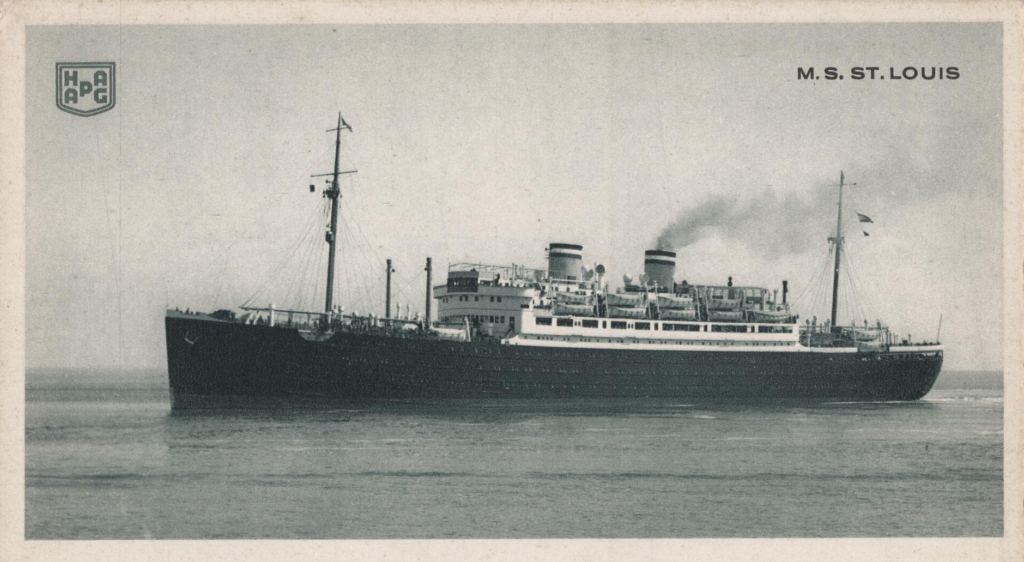
When the Hamburg America Line’s St. Louis departed on May 14, 1930, 32 passengers were part of the Germania delegation. Accompanying the players were Deutscher Sport Verein. president Otto Fitterer and vice-president Emil Fitterer. The Milwaukee soccer community was quite interested in the tour, so the Milwaukee Herold sent their Sports Editor Richard Baumann to send back periodic updates.[34]
Soon after departing, the travelers congregated in the canteen. However, as Richard Baumann so eloquently noted, “Neptune rose and wanted victims.” Seasickness was prevalent among all of the passengers. According to Baumann, the ladies were hit first and then the men. Kondziela was one of the few unaffected and even ate eight eggs in that first meal while the other survivors finished off any drinks that were left unattended.
Eventually, the group recovered and began to enjoy the voyage. Dancing, singing, drinking, and the non-stop playing of the card game ‘skat’ made the group, particularly the footballers, highly regarded by the rest of the passengers. Müller apparently drank with all the available young ladies, while Kärcher consistently sang in the wrong key.[35]
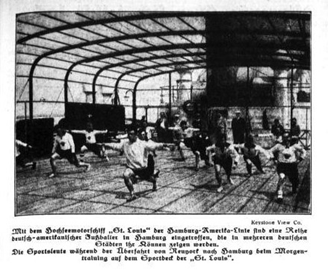
Willi Falk was unanimously elected captain and coach and led light training of the ‘upright ones’ for the first few days of the voyage. After that, more thorough training was conducted with calisthenics, as well as football drills of passing, stopping, and heading.[36]
After crossing the Atlantic Ocean, the St. Louis made a stop in Cork, Ireland, and then in Cherbourg, France. The ship arrived in Cuxhaven, Niedersachsen, on Saturday, May 24. Half of the other passengers promised that they would attend one of the squad’s games. The Germania team then traveled 130 kilometers to Hamburg. The plan was to watch a local match on Sunday, train on Monday and Tuesday, rest on Wednesday, and then play against Hamburg SV on Thursday.[37]
May 28, 1930: Hamburg SV 2-1 Germania
The first matched on May 28, 1930, pitted Germania against Hamburg SV, a club that traced its roots back to 1887. Prior to the game at the Rothenbaum Stadium, members of the Germania delegation laid a wreath on the memorial to HSV’s fallen soldiers from the Great War.[38]
Numerous reports noted that Germania had difficulty playing on the soft, grassy field. The German Americans were accustomed to the hard fields back in the States. Hamburg SV went up 1-0 after 7 minutes courtesy of Sveistrup. A high cross from Holzen was mishandled by Herkert and Sveistrup was able to easily tap the ball into the open goal. HSV carried the lead into half. Germania’s play was characterized as “fast, physically tough but not unfair football.”[39] In the first half, Germania showed that it had not yet gelled as a team, as evidenced by their passing and understanding of each other. Germania’s play was much better in the second half and an equalizer eventually came with Esenwein as the goal scorer, who came up with the ball after a scrum in front of the HSV goal.[40] Germania also missed a few additional opportunities, including Lotz who botched an easy goal.[41]
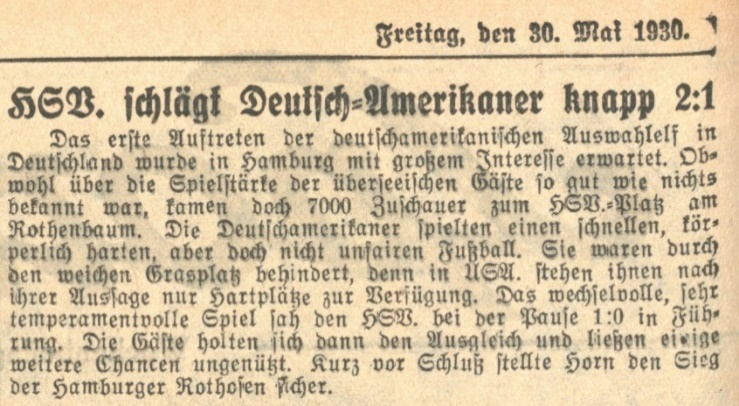
Eventually, Hamburg scored what would be the winning goal, although there were inconsistencies about just how the goal was scored in match reports. The Badische Press said that the game winning goal came from Horn shortly before the final whistle.[42] The Dresdener Nachrichten said it was an own goal by Falk after a shot by Hamburg SV’s Sommer.[43] The Milwaukee Herold’s quoted a Hamburg newspaper report that said it was a rebound from a Horn shot that then was played by Bechos off of Germania’s Falk.[44] The crowd was noted as being of various sizes: 4,000 (Wittener Tageblatt, Dresdener Zeitung, Weisseritz Zeitung); 5,000 (Milwaukee Herold quoting an unnamed Hamburg newspaper); 6,000 (Badischer Zeitung); 7,000 (Neue Mannheimer Zeitung, Badischer Presse, New York Times) Most egregious in terms of misreporting was the stateside coverage in the New York Times whose article was entitled “German-Americans Win, 2 to 1, in Soccer Debut in Berlin.”[45] The truth was that Germania had lost 2-1 in Hamburg.
While the Milwaukee Herold reported on the next game against Hannover, it still had not received word yet about the first game against Hamburg SV.[46] On the very next day, it carried an article about the Hamburg SV game, repeating the incorrect report about a Germania victory.[47] It was not until another week later that the Herold finally had the correct information about the match in Hamburg. The Herold placed the blame on errors in the cabled report.
May 31, 1930: Hannover 96 1-2 Germania
The team next travelled 160 kilometers south from Hamburg to Hanover. Writing in the Milwaukee Herold, Richard Baumann noted a number of differences between the two cities in terms of the reception received by the host clubs. While Hamburg was stern and polite, Hannover was marked by warm friendship. In Hamburg, the players talked about business matters, while in Hannover the conversation was about sports and games.[48]
One common aspect of the two cities was the way the travelers were treated by local establishments. “Workers, hoteliers, and businessman are trying to fleece Americans using every trick in the book,” Baumann observed.[49]
Hannover 96 was a member of the Südkreis of Braunschweig, Hannover, and Nordharz. They had been champions in the preceding 1929-1930 season, finishing five points ahead in the ten-team division.[50]
Against Hannover 96, Germania was superior in terms of technical skill and speed, but overpassing prevented them from scoring more in their 2-1 victory.[51] The Bergische Zeitung reported the crowd at 2,000 while the Milwaukee Herold had it at 5,000 (whom the Herold said repeatedly applauded the visitors for their performance) according to wire reports.[52]
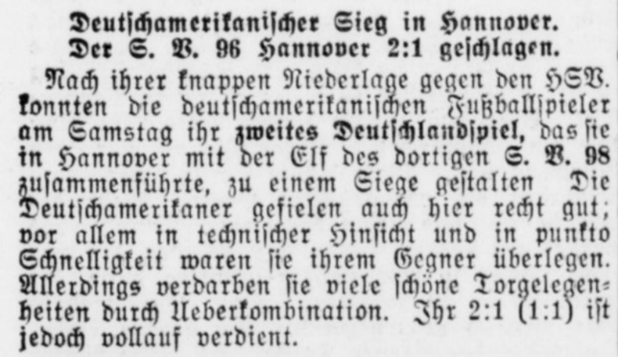
Richard Baumann provided a detailed report for the Milwaukee Herold; however, he did not use any player names. Germania began the game poorly and gave up a goal in the 9th minute. Near the end of the first half, a deflection after a corner kick taken by the outside right led to a Germania goal by the outside left. In the 69th minute, Germania took the lead on a sharp, low shot by the inside left.[53]
Germania had several other scoring opportunities including a one-on-one breakaway and a penalty kick, but they could not increase their lead. The final result stood at 2-1.
Shortly after the match, the squad received a congratulatory telegram from the Wisconsin State Football Association.[54]
After this match, one Germania player, Kondziela, was able to take a small vacation back to his hometown of Thale, in the Harz district of central Germany. He was met with a large crowd at the train station and was processed through the city. He was shown an inscription at a local sports field – “Donated by the Deutscher Sportverein Milwaukee.”[55]
June 6, 1930: Minerva Berlin 1-3 Germania
The trip to Berlin was the longest train ride of the tour, stretching almost 300 kilometers from Hannover to the capital. In the leadup to the game against Minerva Berlin 93, local newspapers had some kind words for the guest out of “Dollarlande.” Both the Deutsche Allgemeine Zeitung and Vorwärts noted the German Americans solid technical ability.[56] While touring through Berlin prior to the match, the players were given free tickets to an acrobat show to serve as hired “clappers.” They also learned some local lingo – “cold duck” meant a punch drink while “half a rooster” meant a slice of cheese.[57]
The match took place on June 6, 1930, at the field of Hertha Berliner Sport Club, winner of the 1930 national title and later an inaugural member of the Bundesliga. There were various estimates of the attendance (6,000 according to the Berliner Börsen-Zeitung and Milwaukee Herold; 4,500 according to the Annener Zeitung; and only 4,000 according to the Münchner Neueste Nachrichten). Richard Baumann noted that American and German flags flew together atop the stadium, and that the poor attendance on this Friday match was due to an election and the Berliners penchant for going to the bars on payday.[58]
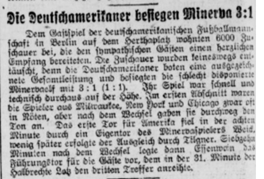
As the players lined up and waited for the referee to whistle the game to begin, a detachment of police officers stepped onto the field and started marching towards the Germania side. The contingent came to a halt next to Kondziela, who admitted to being scared until he recognized one of the officers in the back row. It had been his best friend who had visited Kondziela’s hometown of Harz. The two hugged and the still-confused Kondziela took his place on the field.[59]
While Germania had some difficulty in the first half, they were able to jump out to an early lead thanks to an own goal in the 7th minute. Minerva equalized in the 30th minute on a goal by Tilgner, although the Milwaukee Herold said it came before the Germania bench had finished its cheering from the opening goal.
In the second half, Germania dominated as Minerva could not keep up with the German Americans’ pace.[60] Esenwein put Germania in the lead in the 62nd minute after a series of corners. Lotz ended the scoring in the 76th minute with a magnificent individual goal. Shortly before the final whistle of Germania’s 3-1 victory, Falk had to come off due to injury.[61]
June 15, 1930: VfL Halle 1-3 Germania
The next match on June 15 took Germania about 170 kilometers southwest of Berlin in Halle, a town about 45 kilometers outside of Leipzig. The local newspapers began previewing the match on June 12, with the Hallische Nachrichten reporting that it would be a sensation for Halle that Germania was coming.[62]
The Milwaukee Herold observed that Halle was pleasantly cozy and “snappy” large village. A swimming club in town made their facilities available to the team. The city provided postcards and gifts to the players, although only half the Germania squad could understand the Saxon dialect of the area.[63]
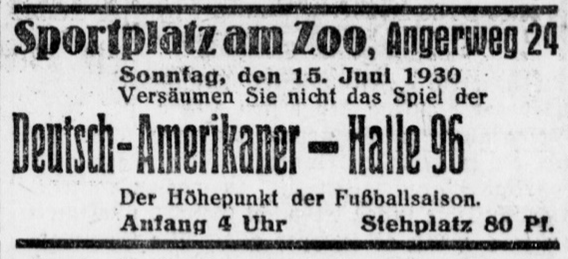
The interest of the newspapers was not matched by the locals with only an estimated 1,700 spectators in attendance. The Saale Zeitung had many kind words about the Germania squad:
They are extremely quick on the ball and maintain the same pace until the end (unreadable). They place little value on a distinctive system and rather play an energetic football that is determined to be successful.
Flat passing often alternates with heading. Physical strength is used carelessly without exceeding the limits of what is permitted. The ball control, passing and build-up are good, and the shot on goal isn’t lacking either, but – they don’t come close to the German top class.[64]
Describing the game as a black day for the 96ers, VfL Halle gifted Germania the lead in the 14th minute with an own goal. A deflection off a Germania defender gave Halle the equalizer in the 32nd minute. However, only three minutes later, Halle handed the lead back to Germania with another own goal. Germania wrapped up the scoring in the 85th minute.[65] The New York Times, however, reported that the Germania goals were from Koerner (2) and Lotz.
June 19, 1930: TSV München 1860 4-1 Germania
Germania next traveled 438 kilometers south, arriving on June 17 in Munich to face TSV München 1860. This would be the club’s toughest test of the tour. 1860 was a top club at the time; the following season they reached the German football championship match.
The squad established their camp in the suburb of Grünwald on the Isar River. In a report to the Milwaukee Herold Baumann described the area’s beauty – the air, the view, the beach, the forests, the food, and drink. When it came to drink, Baumann was focused on beer. Six liters of it could be purchased for a measly 75 cents.[66]
The group visited a number of local sights – churches, town hall, monuments, a carillon, and several breweries. Baumann reported some anecdotes from this portion of the trip: Kondziela missed a train connection; Koerner’s dress suit was ruined by an overflying bird; Rosa Patek collected items that the players lost; Müller slept an inordinate amount; Kuntner surprised the locals when he ordered soda instead of beer; and the world-famous Hofbräuhaus seemingly only employed “women of the oldest generation.”[67]
The Münchner Neueste Nachrichten hoped that Germania would present themselves well in the match. The paper noted that the club’s style was quite modern, because most of the players came from southern Germany, had a strong defense, and talented players in the form of Falk and Patek.[68]
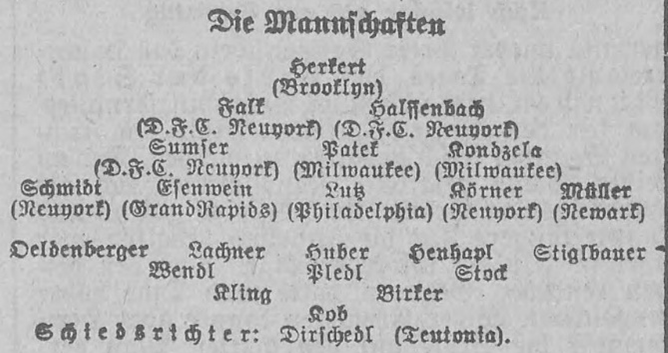
1860 came out fast, hitting the goalpost twice before opening the scoring in the 15th minute. Germania equalized a minute later after some fine play by Körner.
After that, Germania utilized their combination play and speed to take back the advantage. A poor back pass from Falk provided an opportunity to a lightning-fast 1860er. Herkert made the save, but his hands were injured in the process. After a short while, he was able to resume play.[69]
1860 took the offensive, with five good scoring chances. Mueller had one for Germania shortly before halftime. The hosts had a 4-1 advantage in corner kicks at the break. Münchner Neueste Nachrichten noted that the 1860s attack was sluggish and the defense was insecure.[70]
Returning from halftime, Germania was on the front foot. Kuntner put a shot barely over the crossbar, and 1860’s netminder Kob deflected a second hard shot for a corner. Wegener was knocked out in a collision, and Sumser came in as a substitute. Germania gained six consecutive corners.
Then, 1860 “remembered their reputation” and began attacking more productively. Three goals were scored in quick succession, one from Huber in the 72nd minute and then two more from Lachner on assists from Oeldenberger. The hosts were clearly the superior team in the second half. The visitors were judged to be on par with the middle district league squad. The 3,000 fans in attendance were treated to a good display from the German Americans. “They played commendably fairly, eagerly and quickly, sometimes showing good combination moves and individual performances.”[71] The onetime local Willi Falk received special applause at halftime.
June 21, 1930: Eintracht Frankfurt 4-0 Germania
It was a quick turnaround to play the next game only two days later when Germania traveled 392 kilometers to the northwest to play Eintracht Frankfurt. The reigning Southern German champions, and quarterfinalist for the national championship, Eintracht fielded several reserves in place of their regular starting eleven, but in the end, Frankfurt had little trouble in handing Germania its worst defeat of the tour.
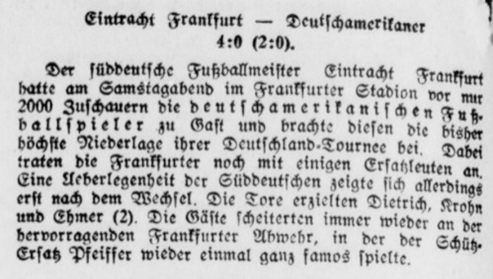
Germania managed to hold Frankfurt scoreless in the first half, although the German Americans could not generate much offense themselves. In the second half, the hosts showed their superiority with goals by Dietrich, Krohn, and two from Ehmer to win 4-0.[72]
Attendance was much lower than expected (1,200 according to Frankfurter Echo; 2,000 according to Fussball, only 800 according to the Dresdner Nachrichten). A temperature of above 30C (86F) reigned that day, keeping the fans away and the gate receipts down. While the profit was to be shared equally, Eintracht graciously waived their portion of a few hundred marks and gave it to Germania.[73] Baumann, who estimated the crowd at 2,000 in his report, complained of the heat, of the referee’s “pettiness” for whistling so often, and of the general football fatigue of the locals.[74]
June 25, 1930: Karlsruhe FV 3-7 Germania
Germania then turned 137 kilometers south towards Karlsruhe for its final match on June 25, 1930, against Karlsruhe FV. The fixture was originally scheduled for June 18, but it was rescheduled so that Germania could play 1860.[75] The locals were eager for the match as evidenced by advertisements in the Süddeutsche Zeitung and Badische Beobachter. The club had been the champion of Southern Germany eight times between 1901 and 1912, and they would be Bezirksliga Baden champion in the upcoming 1930-1931 season.[76]
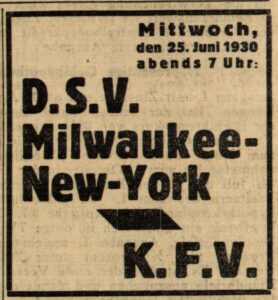
Both the Badische Beobachter and Bergische Presse previewed the match and reported on the good performance of the Germania squad, both in terms of sportsmanship and play.
From the very start, Germania had the upper hand and took the lead in the 12th minute. Then the play began to spread out and KFV began to dominate, and the host got the equalizer in the 25th minute from Kastner. Germania took a 2-1 lead on a shot from Körner and then an own goal from KFV’s Stadler made in 3-1. Schneider reduced the deficit in the 38th minute to 3-2. Shortly after halftime it was Körner again to up the lead to 4-2. Minutes later, Esenwein tallied to make it 5-2. KFV then began to assert themselves and Keller pulled a goal back for a 5-3 difference. After that, Germania took control again and goals from Lotz and Schmidt put the final score at 7-3.
The tour concludes
In terms of the results on the field, DSV Germania performed most admirably against the high-quality teams of the homeland of its players. The squad posted a final record of four wins and three losses, with seventeen goals for and sixteen goals against. The various newspaper reports held that those in attendance, were impressed, if slightly surprised, by the German Americans’ quality of play. While Germania was completing its tour the US men’s national team was preparing to embark for Uruguay to participate in the 1930 World Cup, where it reached the semifinals. In August 1930, Fall River Marksmen travelled to Central Europe for games in Czechoslovakia, Austria, and Hungary.
On July 28, the Milwaukee Herold had a final writeup from the traveling sport editor Richard Baumann. He related how the squad had left good impressions everywhere they played, garnering appreciative reporting from the local papers. While initially overwhelmed in the first match against Hamburg SV, “[t]he self-confidence was there and thus laid the foundation for later victories.”[77]
Baumann wrote of the team,
Every single one of our players put their heart and soul into it. A skillful, confident, fearless goalkeeper; two sturdy defenders, one the skilled tactician, the other the brash daredevil; a trio of midfielders who, with the help of brilliant technique and admirable stamina, were the backbone of the team offensively and defensively, and finally a striker quintet who were familiar with all the finer points of football and, despite all their technique, had not forgotten how to shoot.[78]
He also had high praise for Milwaukee’s two players on the squad:
Heini Kärcher initially suffered from stage fright, which had an adverse effect on his ability, but from game to game he became more confident and by the end of the tour he had regained a form that made him an exceptionally talented center forward, even by German standards … Frank (Hannes) Kondziela was the always reliable, unassuming player that we have long known here in Milwaukee. As a left-wing attacker, he didn’t always stick to his wing as much as one would have liked, but he made up for this shortcoming by tirelessly helping out in the middle and in defense. He played his biggest game in Berlin. Hey, how did he drive between the technically first-class Minerva strikers and what a bulwark he became when he had to be taken back into cover in place of our injured international defender Willi Falk. Milwaukee can be proud of these two players.[79]
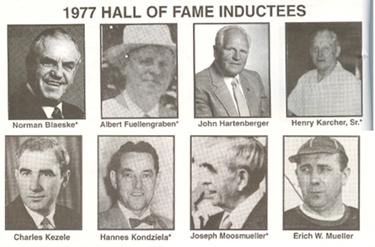
Also commended were those participants who took care of the administrative roles on the trip: Otto Fitterer, Emil Fitterer, Fred Patek, and Fritz Rohrmann. There were some difficulties associated with the arrangements, demonstrated by the scheduling and the financial performance. The unusual heat and the public’s interest in the German championship detracted from the attention the squad could have received. Still the trip was a success, and the team could be proud of the way they played. Baumann ended with the following observation:
The pronounced system of positional play has taken away much of football’s fresh fighting spirit and made the crowds smaller. The favorites of the audience are teams that don’t pass the ball from man to man like chess pieces and barely get warm, but use all their skills and dart across the field with a dash as if they had been powdered with paprika … our team followed this system.[80]
In 1957, the Milwaukee Herold’s Guenther Heinrich wrote five installments entitled “Soccer Sensation 1930” about the adventures of DSV Germania. He gathered the reports from his predecessor Richard Baumann as well as some “dearly guarded” German newspapers that had been collected during the tour by the Milwaukee participants. He also talked with the Milwaukeeans about their memories of the trip. In conclusion, Heinrich wrote in his inimitable way:
Whether we will play together again was the big question and it has remained unanswered to this day. Gone to the winds, as well as individual returns ended the “great journey” of Germania. It was thought that this sporting act would make the hard path of football easier, and there were signs, but there were bitter and hard setbacks, some of which we can still feel today. But one thing remained, dear sports friends, from then and now, your probably unique great sporting act, which we should stick to, cling to and achieve again.[81]
Five years later in 1962, the Bavarian Soccer Club fulfilled Heinrich’s wish to undertake a soccer tour of Germany. That, however, is a story for another day.
Endnotes
[1] Ed Farnsworth, “Philly and the first USA international tour,” Society for American Soccer History, accessed November 29, 2024, https://www.ussoccerhistory.org/philly-and-the-first-usa-international-tour/
[2] Ed Farnsworth, “Bethlehem Steel FC’s 1919 tour of Scandinavia,” Society for American Soccer History, accessed November 29, 2024, https://www.ussoccerhistory.org/bethlehem-steel-fcs-1919-tour-of-scandinavia/
[3] Ed Farnsworth, “St. Louis Soccer Club tour of Sweden, 1920,” Society for American Soccer History , accessed November 29, 2024, https://www.ussoccerhistory.org/st-louis-soccer-club-tour-of-sweden-1920/
[4] “Wissen sie schon?” Milwaukee Herold, December 8, 1929.
[5] “Auswärtige Fußballgäste in Berlin,” Berliner Börsen-Zeitung, March 11, 1930.
[6] Mark D. Van Ellis, “How Milwaukee’s German-Americans faced down fascism eighty years ago,” March 17, 2017, https://www.milwaukeeindependent.com/articles/how-milwaukees-german-americans-faced-down-fascism-eighty-years.
[7] “Fußball-Reise nach Deutschland,” Milwaukee Herold, March 16, 1930.
[8] “Fußball-Reise nach Deutschland.”
[9] “Fußball-Reise nach Deutschland.”
[10] “Fußball-Reise nach Deutschland.”
[11] “Fußball-Reise nach Deutschland.”
[12] “Besuch aus USA,” Duisburger General Anzeiger, March 31, 1930.
[13] “Fußball Reise beginnt am 14. Mai,” New Yorker Staats-Zeitung, April 12, 1930.
[14] “Auswahlspiel gegen Professionals,” New Yorker Staats-Zeitung, April 10, 1930.
[15] “Morgen ist der groß Fußball Kampf,” New York Times, April 19, 1930
[16] “Sieg der deutschen Repräsentativ-Elf,” Milwaukee Herold, April 22, 1930.
[17] “Scheffel Hall,” accessed November 29, 2024, https://en.wikipedia.org/wiki/Scheffel_Hall.
[18] “Wilhelm Falk (Fußballspieler),” accessed June 1, 2024, https://de.wikipedia.org/wiki/Wilhelm_Falk_(Fußballspieler)
[19] “Die deutschamerikanische Fußballer zur Deutschland-Fahrt gerüstet,” Milwaukee Herold, April 27, 1930.
[20] Milwaukee Herold, April 27, 1930.
[21] “U.S.A. kommt,” Duisburger General Anzeiger, April 29, 1930.
[22] “Deutschland Fahrer spielen Dienstag vs. Newark-Americans,” New Yorker Staats-Zeitung, May 3, 1930.
[23] “Das Auftreten deutsch-amerikanischer Fußballer in Deutschland,” Hohenstein-Ernstthaler Tageblatt und Anzeiger, May 3, 1930.
[24] “How Milwaukee’s German-Americans faced down fascism eighty years ago.”
[25] “Abschiedsfeier der Deutschlandfahrer,” Milwaukee Herold, May 4, 1930.
[26] “Fußballspieler nach dem Ostens unterwegs,” Milwaukee Herold, May 8, 1930.
[27] “Versammlung der Deutschlandfahrer,” New Yorker Staats-Zeitung, May 8, 1930.
[28] “Zwei Uebeungspiele,” Milwaukee Herold, May 10, 1930
[29] “Deutschland Fahrer spielen,” New Yorker Staats Zeitung, May 13, 1930.
[30] “Baumann abgereist,” Milwaukee Herold, May 18, 1930.
[31] Milwaukee Herold, May 18, 1930.
[32] Milwaukee Herold, May 18, 1930.
[33] “Deutschamerikanische Fußballer in Deutschland, “Badischer Presse, May 15, 1930.
[34] Milwaukee Herold, February 13, 1957.
[35] Richard Baumann, “Die Ueberfahrt der Fußballer,” Milwaukee Herold, June 1, 1930.
[36]“Die Ueberfahrt der Fußballer.”
[37] Milwaukee Herold, June 1, 1930.
[38] Richard Baumann, “Aus Sieg wurde Niederlage,” Milwaukee Herold, June 11, 1930.
[39] Badische Press, May 15, 1930.
[40] Milwaukee Herold, June 11, 1930
[41] “Hamburger S.V. Deutschamerikaner 2:1 (1:0)” Wittener Tageblatt, May 31, 1930.
[42] “HSV schlägt Deutsch-Amerikaner knapp 2:1,”Badische Press, May 30, 1930.
[43] “HSV Gegen Deutschamerikaner 2:1 (1:0),”Dresdener Nachrichten, May 30, 1930.
[44] Milwaukee Herold, June 11, 1930
[45] “German-Americans Win, 2 to 1, in Soccer Debut in Berlin,” New York Times, May 29, 1930.
[46] Richard Baumann, “Hannover 96 mit 2:1 geschlagen,” Milwaukee Herold, June 3, 1930.
[47] Richard Baumann, “Hamburger Sportverein geschlagen,” Milwaukee Herold, June 4, 1930.
[48] Richard Baumann, “Streiflichter von der Deutschland-Elf,” Milwaukee Herold, June 15, 1930.
[49] Milwaukee Herold, June 15, 1930.
[50] “Südkreis: Braunschweig, Hannover, Nordharz 1930, 1.Klasse,” accessed June 1, 2024, http://www.fussball-historie.de/Nord/Braunschweig1930.html
[51] “Deutschamerikanischer Sieg in Hannover,” Bergische Zeitung, June 2, 1930.
[52] Milwaukee Herold, June 3, 1930.
[53] Milwaukee Herold, June 15, 1930.
[54] Milwaukee Herold, June 15, 1930.
[55] Richard Baumann, “Der Sieg über Halle ‚96,”Milwaukee Herold, June 29, 1930.
[56] “Berlins Pfingst Fußballschlager,” Deutscher Allgemeine Zeitung, June 6, 1930; Vorwärts, June 6, 1930.
[57] “Berlin wurde eines Besseren belehrt,” Milwaukee Herold, June 22, 1930.
[58] Milwaukee Herold, June 22, 1930.
[59] Guenther Heinrich, “Fußball Sensation im Jahre 1930,” Milwaukee Herold, February 22, 1957.
[60] “Fußballsieg der Deutschamerikaner,” Münchner Neueste Nachrichten, June 8, 1930.
[61] “Minerva Berlin gegen Deutschamerikaner,” Annener Zeitung, June 10, 1930.
[62] “Halle 96 empfangt die Deutschamerikaner,” Hallische Nachrichten, June 12, 1930.
[63] Milwaukee Herold, June 29, 1930.
[64] “Sieg der Deutschamerikaner,” Saale Zeitung, June 16, 1930.
[65] “Die Amerikaner auch in Halle siegreich,” Saale Zeitung, June 16, 1930.
[66] Richard Baumann, “Spielberichte der Deutschland-Elf,” Milwaukee Herold, July 5, 1930.
[67] “Spielberichte der Deutschland-Elf.”
[68] “Deutschamerikaner spielen Fußball,” Münchner Neueste Nachrichten, June 18, 1930.
[69] “Spielberichte der Deutschland-Elf.”
[70] Münchner Neueste Nachrichten, June 18, 1930.
[71] Münchner Neueste Nachrichten, June 18, 1930.
[72] “Eintracht Frankfurt – Deutschamerikaner,” Bergische Post, June 23, 1930.
[73] “Deutschamerikaner in Frankfurt,” Frankfurter Echo, June 24, 1930.
[74] Milwaukee Herold, July 5, 1930.
[75] “Deutschlandelf unterlag,” Milwaukee Herold, June 21, 1930.
[76] “Karlsruher FV 1891 e.V.,” accessed September 2, 2024, http://www.fussball-historie.de/Vereine/Sued/KarlsruherFV.html
[77] “Nekrologisches zu der Deutschland-Reise der Fußballmannschaft ,Germania‘,” Milwaukee Herold, July 28, 1930.
[78] Milwaukee Herold, July 28, 1930.
[79] Milwaukee Herold, July 28, 1930.
[80] Milwaukee Herold, July 28, 1930.
[81] Guenther Heinrich, “Fußball Sensation im Jahre 1930,” Milwaukee Herold, March 13, 1957.
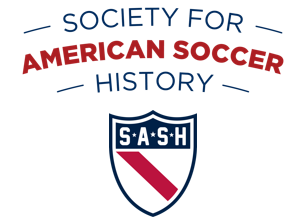
I was so pleased to read this article. My sister found it. Our father was Paul Esenwein. We did not know that he scored as many goals as he did in this tour. We knew he had gone with this team but that is all. Thanks!